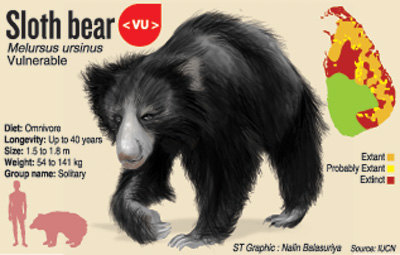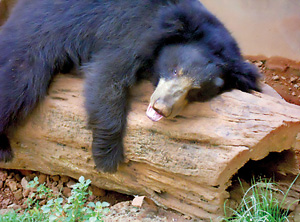News
Road to freedom becomes a dream for born free bears
View(s):A roar of protest has gone up from animal lovers at a plan to transfer four young sloth bears under the guardianship of Department of Wildlife to the National Zoological Gardens, with calls for the bears to be rehabilitated and released to live free in the wild instead of in a cage.
 The bears were to have been released into the wild but upon a request by the Director of the Zoological Gardens, the Director General of Department of WIldlife Conservation issued a hurriedly executed directive last month to transfer them to a zoo.
The bears were to have been released into the wild but upon a request by the Director of the Zoological Gardens, the Director General of Department of WIldlife Conservation issued a hurriedly executed directive last month to transfer them to a zoo.
Three of these orphaned bears, rescued from northern wilderness areas, were rehabilitated at the Udawalawe Elephant Transit Home (ETH) while the other one is being cared for at the Giritale Wildlife Training Centre. The eldest bear at Udawalawe is a well-grown male, aged about two and half years, rescued from the Kilinochchi jungles. The other two cubs, siblings of one and half years, were rescued from Vakarai.
The Elephant Transit Home was set up with the aim of rehabilitating orphaned elephants and later releasing them to the wild. Several batches of elephants have been successfully released and the staff had been trying to rehabilitate these bears too, with the intent of sending them back to the forests.
The eldest bear had, in fact, been released to the wild recently but the attempt failed as it was found with head injuries few days after release. It is believed the bear, which had lost fear of humans, would have gone too close to a gang of hoodlums that often infiltrates the Udawalawe jungles.
Even though the bear would have meant no harm, those who had panicked by its approach would have attacked and injured it. Luckily for the bear, it was fixed with a radio collar and the ETH team that was constantly monitoring it went to its rescue as they noticed the bear had stopped moving.

A sloth bear in Dehiwela Zoo
The other two bear cubs had grown much in isolation so carers had hoped they would have a higher chance of survival. Sources close to the ETH revealed that plans for releasing these bears to Yala Block-II had already been underway. The bears were being habituated to a new environment by being kept in a large enclosed wilderness area before their release, and they were to be closely monitored as they adapted to the wild.
Zoological Gardens Director Anura Silva said the bears would be given a half-acre enclosure at a zoo at Wagolla in Pinnawala. The Pinnawela zoo needed more animals, and instead of capturing them from the wild the zoo had asked for these orphaned bears, he said.
Mr. Silva said the zoo hoped to breed them in captivity. The Dehiwela zoo has a few sloth bears but the zoo was finding it difficult to breed them, he said.Mr. Silva gave assurances that the bears’ welfare would be looked after.
DWC Director-General H.D. Ratnayake said the bears had been handed over to the zoo as that had been the best option. The director of the zoo had requested sloth bears for the new zoo at Pinnawela, he said. As the law permitted the capture of wild animals for the zoo if the necessity arose, sending these bears to the zoo meant sloth bears would not be captured from the wild.
Mr. Ratnayake pointed out that there were difficulties in rehabilitating the bears in their current condition and they might not have survived in the wild. He revealed that there are doubts that a leopard that had been rehabilitated and released had survived.
The sloth bear (Melursus ursinus), among the big five tourist attractions in the Sri Lankan wilderness, is listed as “endangered” and is becoming closer to extinction. It is important to protect the wild population and the attempt to rehabilitate and release the orphaned animals back to the wild is indeed a noble task. Biologists point out however, that this involved much work and such releases should not be carried out in a haphazard manner.
More issues than food needed to be considered. There needed to be very good rehabilitation facilities, said Dr. U.K. Padmalal who was involved in sloth bear research in Wasgamuwa a few years ago. Habitat selection should be done carefully and it was also important to release cubs to environs close to where they were initially found as there could be different genes in other sloth bear populations.
It seems that the fate of these orphaned bear cubs is to remain in captivity but as sloth bears are a threatened species it is important that a state-of-the-art facility be built to rehabilitate and release them back to the wilderness in the future.

